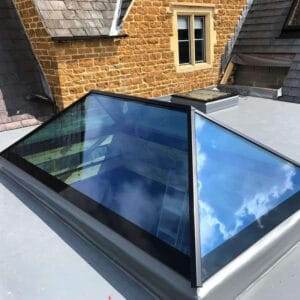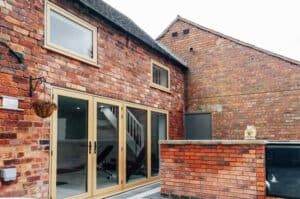What are Sash Windows?
Sash windows are a type of window that is composed of two parts, called “sashes.” The sashes are typically made of wood or uPVC, and they slide vertically up and down within the frame of the window. The top sash is usually smaller than the bottom sash, and both sashes can be opened to allow for ventilation. Sash windows are often used in older homes, as they provide a classic look. However, they can be found in new construction as well.
The History of Sash Windows
Sash windows are a traditional window style that has been around for centuries. The name ‘sash’ comes from the fact that these windows are made up of two parts (or ‘sashes’), which slide past each other to open and close the window.
Sash windows were first used in the 17th century, and they quickly became popular thanks to their elegant look and practical design. These windows were typically made from wood, but over time, different materials have been used to make sash windows, including uPVC and aluminium.
One of the main benefits of sash windows is that they can be opened without taking up any space inside your home. This makes them ideal for small rooms or spaces where you don’t want to lose any floor space to a window opening.
Another benefit of sash windows is that they are very energy efficient. When closed, these windows create an airtight seal that helps to keep heat in your home during winter and out during summer. This means that you could save money on your energy bills by installing sash windows in your home.
If you’re thinking about replacing the old windows in your home with something more modern, then timber sash windows could be a great option for you. These beautiful windows can give your home a classic look while also providing all of the benefits mentioned above.
The Benefits of Sash Windows
There are many benefits to having sash windows in your home. Sash windows can add a touch of class and elegance to any room, and they can also help to keep your home warm in the winter and cool in the summer. Here are just some of the benefits of sash windows:
1. Sash windows can help to keep your home warm in the winter. The reason for this is that sash windows are usually made with double-glazed glass, which helps to trap heat inside your home. In addition, sash windows often have draft proofing around the edges, which further helps to keep heat inside your home.
2. Sash windows can also help to keep your home cool in the summer. This is because double-glazed glass helps to reflect heat away from your home, and because sash windows are often located high up on walls, they don’t absorb as much heat from the sun as lower windows do.
3. Sash windows can add a touch of class and elegance to any room. Whether you choose uPVC or timber sash windows, there’s no denying that these window types add a certain level of sophistication to a room. If you want to make a good impression on guests or potential buyers, then installing sash windows could be a great way to do it.
4. Sash Windows are easy to clean. Because they open outward rather than inward, there is no need for step ladders or other forms of precarious access in order to reach the outside panes. You can simply lean out of an open window and give them a wipe-down! This is great news if you live in a tall house or struggle with mobility issues.
The Different Types of Sash Windows
Sash windows are a traditional window style that has been used in homes for centuries. There are two main types of sash windows: uPVC sash windows and timber sash windows. Each type has its own benefits and drawbacks, so it’s important to choose the right one for your home.
uPVC Sash Windows:
uPVC sash windows are a popular choice for many homeowners because they require little maintenance and are very energy efficient. However, uPVC windows can be more expensive than timber windows, and some people prefer the appearance of timber windows over uPVC.
Timber Sash Windows:
Timber sash windows add a touch of elegance to any home and can be stained or painted to match your home’s décor. Timber windows also last longer than uPVC windows, but they require more maintenance and are not as energy efficient.
How to Measure for Sash Windows
When it comes to measuring for sash windows, there are a few things you need to take into account. The first is the type of window you have. Are you looking for uPVC sash windows or timber sash windows? Each type of window will require different measurements.
uPVC Sash Windows:
The first step is to measure the width of your opening at the top, middle and bottom. Once you have these measurements, you can then take an average of the three. This will give you the overall width of your opening.
Next, measure the height of your opening at the left, middle and right-hand sides. As before, take an average of these three measurements to get the overall height of your opening.
Now that you know the width and height of your opening, you can start thinking about which size window would be best suited. All our uPVC sash windows come in a range of standard sizes so finding one to fit shouldn’t be a problem!
Timber Sash Windows:
For timber sash windows, we recommend using our made-to-measure service where we will manufacture your windows specifically for your home. We believe this offers a much better finish and ensures a perfect fit every time!
Get in touch today to find out more about our made-to-measure timber sash windows!
How to Install Sash Windows
Sash windows are a type of window that has one or more movable panels, or ‘sashes’, that slide up and down to open and close the window. They’re a popular choice for both traditional and contemporary homes as they offer good ventilation while still looking great.
There are two main types of sash windows – uPVC and timber. uPVC sash windows are made from PVCu (polyvinyl chloride unplasticised), which is a strong, durable and low-maintenance material. Timber sash windows are usually made from softwood, although hardwood options are also available. Both types of windows come in a variety of styles to suit different properties.
Installing sash windows is a relatively straightforward process, but there are a few things you need to take into account before you start. First, you need to make sure that the frame of the window is level and square. If it isn’t, the window won’t fit properly and could cause problems further down the line.
Next, you need to choose the right type of glazing for your new sash windows. There are two main options – single glazed and double glazed. Single-glazed windows have one sheet of glass in each pane, while double-glazed windows have two sheets of glass with a layer of air between them. Double glazing is more energy-efficient than single glazing, so it’s worth considering if you want to keep your home warm during the winter months.
Once you’ve chosen your glazing, you can start installing the window itself. The process differs slightly depending on whether you’re installing uPVC or timber sash windows, but generally speaking it involves attaching the bottom rail of the window frame to the sill using screws or nails before attaching the top rail in the same way. Once both rails are in place, you can then add your chosen style of glass before securing it with putty or tape around all four edges
How to Clean Sash Windows
UPVC Sash Windows
The first step is to remove any build-up of dirt and debris from the surface of your windows. You can do this by using a soft cloth or brush to gently wipe away any grime. If there are any stubborn marks, you can use a mild detergent and warm water to help break them down. Once you have removed all the surface dirt, you will need to rinse the area with clean water to remove any soap residue.
To clean the inside of your UPVC sash windows, start by opening the window so that you can access both sides of the glass. Use a soft cloth or sponge to wipe down the glass, paying special attention to any areas that seem particularly dirty. Once you have cleaned all the glass, close the window and move on to cleaning the frame.
To clean the outside of your UPVC sash windows, start by opening the window and leaning out so that you can reach both sides of the frame. Use a soft cloth or brush to wipe away any dirt or debris from the surface of the frame. If there are any stubborn marks, you can use a mild detergent and warm water to help break them down before rinsing with clean water. once you have cleaned all sides of the frame, close the window and move on to cleaning
Timber Sash Windows
The first step is to remove any build-up of dirt and debris from the surface of your windows. You can do this by using a soft cloth or brush to gently wipe away any grime. If there are any stubborn marks, you can use a mild detergent and warm water to help break them down before rinsing with clean water.
To clean the inside of your timber sash windows, start by opening the window so that you can access both sides of the glass.
Useasoftclothorspongetowipedowntheglass, paying special attention to any areas that seem particularly dirty.
Once you have cleaned all the glass, close the window and move on to cleaning the frame.
FAQs About Sash Windows
1. What are sash windows?
Sash windows are a type of window that consists of two or more panels, or “sashes,” that slide vertically up and down to open and close the window. The panels are usually set in a frame made of wood, although some newer models may be made of uPVC or other materials.
2. How do sash windows work?
The sashes on a sash window are connected to one another via pulleys, weights, and cords (or chains). As one panel is raised, the other is lowered. This allows for ventilation while still keeping the window secure.
3. Why are sash windows called “sash”?
The term “sash” is derived from the French word “chassis,” which means “frame.” The name was eventually adopted by English speakers to refer to the entire window frame, including the panes of glass.
4. Where did sash windows originate?
Sash windows were first used in England during the 17th century. They quickly became popular due to their simple design and functionality. Today, they can be found all over the world in both historic and modern buildings alike.













